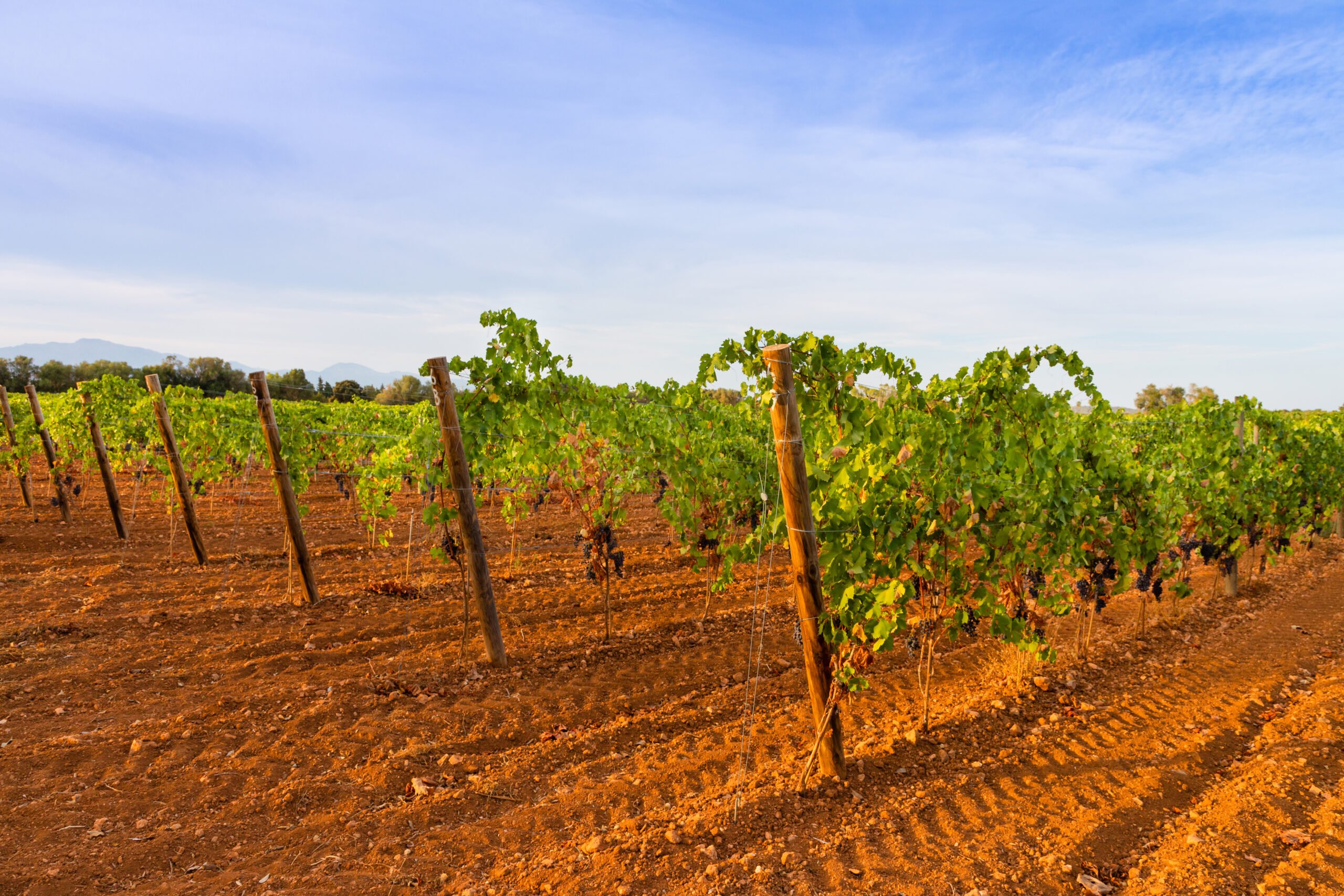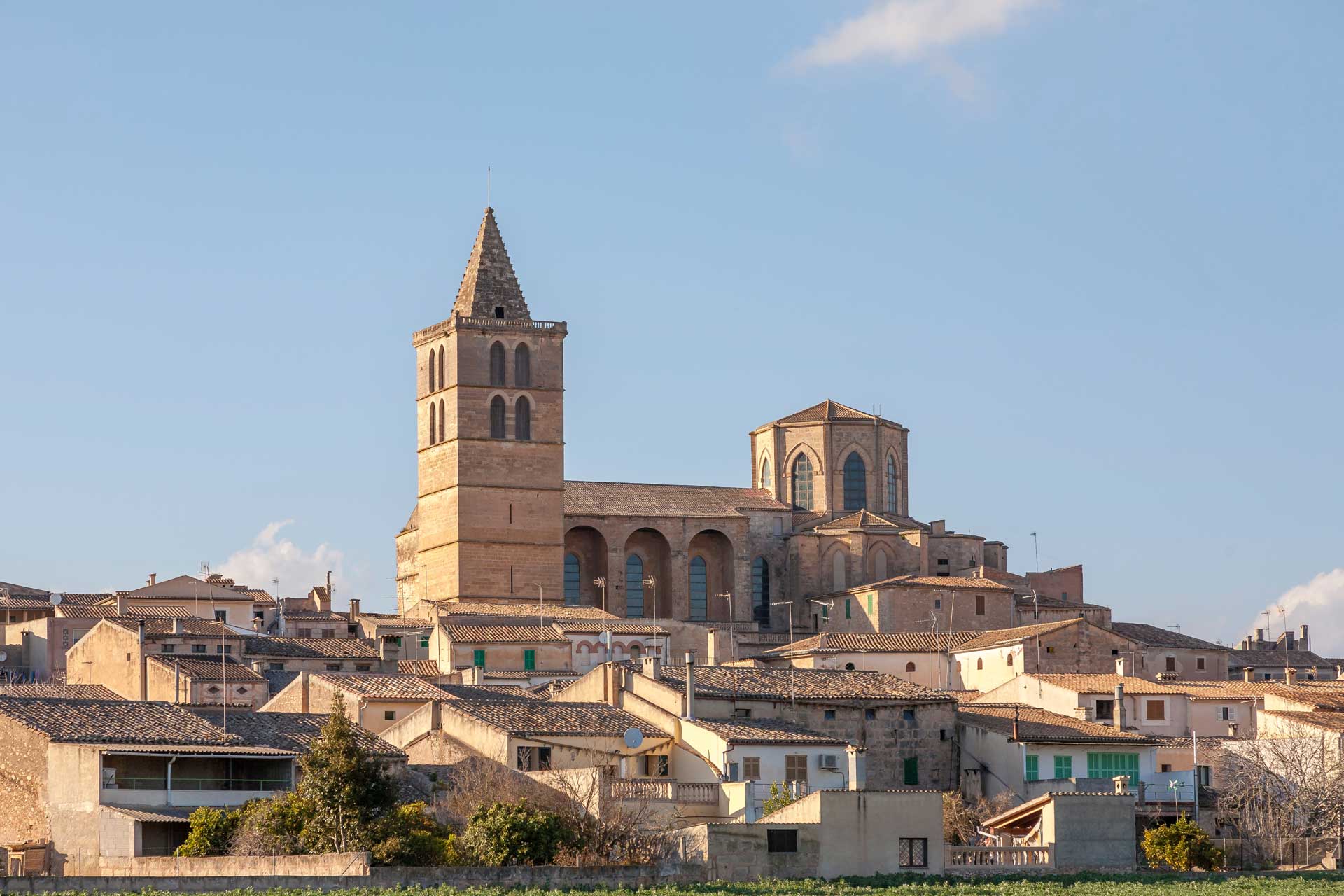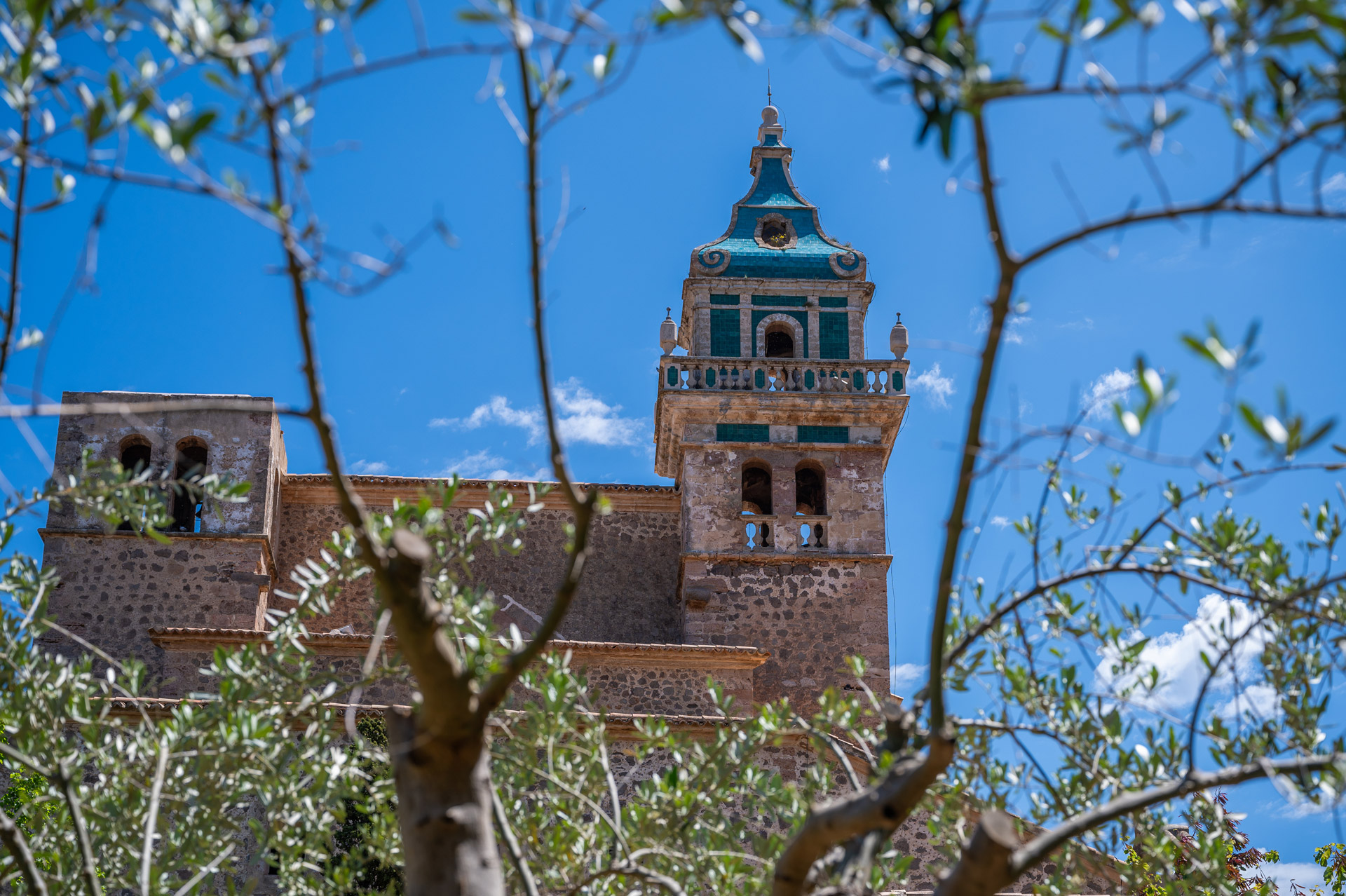The history of Llucmajor is closely linked to the destiny of Mallorca. Known for the battle of 1349, it marks the end of the independence of the Kingdom of Mallorca. However, Llucmajor’s roots date back to the Bronze Age, making the region particularly attractive to history buffs.
Archaeological sites such as Capocorb Vell bear witness to a rich past. These prehistoric remains immerse visitors in a distant era and allow them to understand the evolution of human civilization in Mallorca.
In the town itself, the medieval legacy can be seen in buildings and monuments, such as the monument to King James III, who lost his life in the aforementioned battle. This event has shaped the historical structure of the town and remains an essential part of the local identity.
A brief history of Llucmajor
The history of Llucmajor dates back to prehistoric times, as evidenced by the Talayotic sites found in the municipality, including the settlement of Capocorb Vell, one of the most important on the island. This archaeological site, located near the south coast, shows how an organized community already existed in the Bronze Age, living in circular stone towers and making use of the resources of the surrounding area.
During Roman times, the territory was part of the island’s agricultural network, linked to the production of cereals, oil, and wine, although it was not until the Middle Ages that Llucmajor acquired significant historical importance. In 1349, it became the scene of the decisive battle between the troops of Peter IV of Aragon and King James III of Mallorca, who died in combat. This event marked the end of the independent Kingdom of Mallorca and its definitive reintegration into the Crown of Aragon. The place where the king fell is marked by a commemorative cross on the outskirts of the town center.
In the centuries that followed, Llucmajor grew as an agricultural, commercial, and artisan center. It was known for its production of footwear and agricultural products such as almonds, figs, carob, and wine. Starting in the 19th century, the town underwent a significant urban transformation, with the construction of squares, markets, and public buildings that still shape its daily life today.
During the 20th century, the expansion of new infrastructure and the growth of tourism in Mallorca gave a new boost to the municipality, especially in its coastal area. However, the historic center has managed to maintain its identity, becoming a place where tradition and modernity coexist without major tensions.
Today, walking through Llucmajor is like walking through a place where history is not displayed with monumentality, but can be sensed in every street, in every bakery, in every conversation in the square. A town with a memory, but also with an open view to the future.

The Randa mountain: spiritual path and viewpoint in Mallorca
Just a few kilometers from the center of Llucmajor stands the Randa Mountain, a place steeped in symbolism, history, and silence, which has been a place of pilgrimage, retreat, and contemplation for centuries. At 543 meters high, it is visible from much of the south of the island and boasts one of the most expansive and evocative viewpoints in Mallorca.
This mountain is home to three historic sanctuaries: Gràcia, Sant Honorat and Cura, built on different levels of the hillside and linked by a stone path that can be explored on foot, by bike or by car. The ascent offers changing views of the Pla de Mallorca, farmland, small estates and, on clear days, even the distant outline of the island of Cabrera.
The first to appear is the Santuari de Gràcia, nestled in the rock and with a small church that invites you to pause in silence. Higher up is Sant Honorat, founded in the 14th century as a hermit’s retreat. Its austere architecture and peaceful surroundings make it a much-loved place of contemplation.
At the top, 543 meters above sea level, is the Santuari de Cura, the best known of the three. According to tradition, it was here that Ramon Llull retired in the 13th century after his spiritual conversion, beginning his vocation as a philosopher, missionary, and pioneer of European thought. The current complex includes a church, a guesthouse, a small museum, and a restaurant. From its esplanade, visitors can enjoy a 360-degree panoramic view of the island: the Tramuntana mountains to the north, the agricultural plains to the east and south, and the bay of Palma to the west.
The Randa mountain is not only of scenic or religious interest. It is also a place where visitors can experience the quiet and reflective interior of Mallorca, ideal for those seeking disconnection and perspective. The climb is especially recommended in the early hours of the day or at sunset, when the light softens the landscape and the wind is gentler.
Visiting the sanctuaries of Randa is a different way to discover the island: from above, but also from within.
What makes Llucmajor an authentic destination?
Off the beaten tourist track, Llucmajor offers an authentic Mallorcan experience. Here, visitors can soak up the island’s true atmosphere, stroll through unspoiled landscapes, and enjoy the local cuisine.
The town is known for its rich cultural life, which is evident in its markets, festivals, and traditional events.
These events reflect the pride and warmth of the locals and invite travelers to become part of the community.
The town’s shoemaking heritage is another authentic aspect of Llucmajor. The town was once a center of the shoe industry, and some workshops have preserved this tradition to this day. This allows visitors to learn about traditional craftsmanship.
What places of interest are there in Llucmajor?
Llucmajor has a wide variety of places of interest, from the rugged coastline to historic monasteries. Among the most notable are:
- The monastery of Randa, a spiritual place with breathtaking views.
- Capocorb Vell, one of the most important prehistoric sites on the island.
- The monument to Jaume III, commemorating the historic battle of Llucmajor.
The town itself, with its narrow streets and traditional buildings, offers a glimpse into everyday life in Mallorca. The church of San Miguel and the town hall are also worth a visit and give an idea of the architectural beauty of the town.
In addition, the spectacular cliffs and quiet bays along the coast of Llucmajor make this area a paradise for nature lovers and photography enthusiasts.
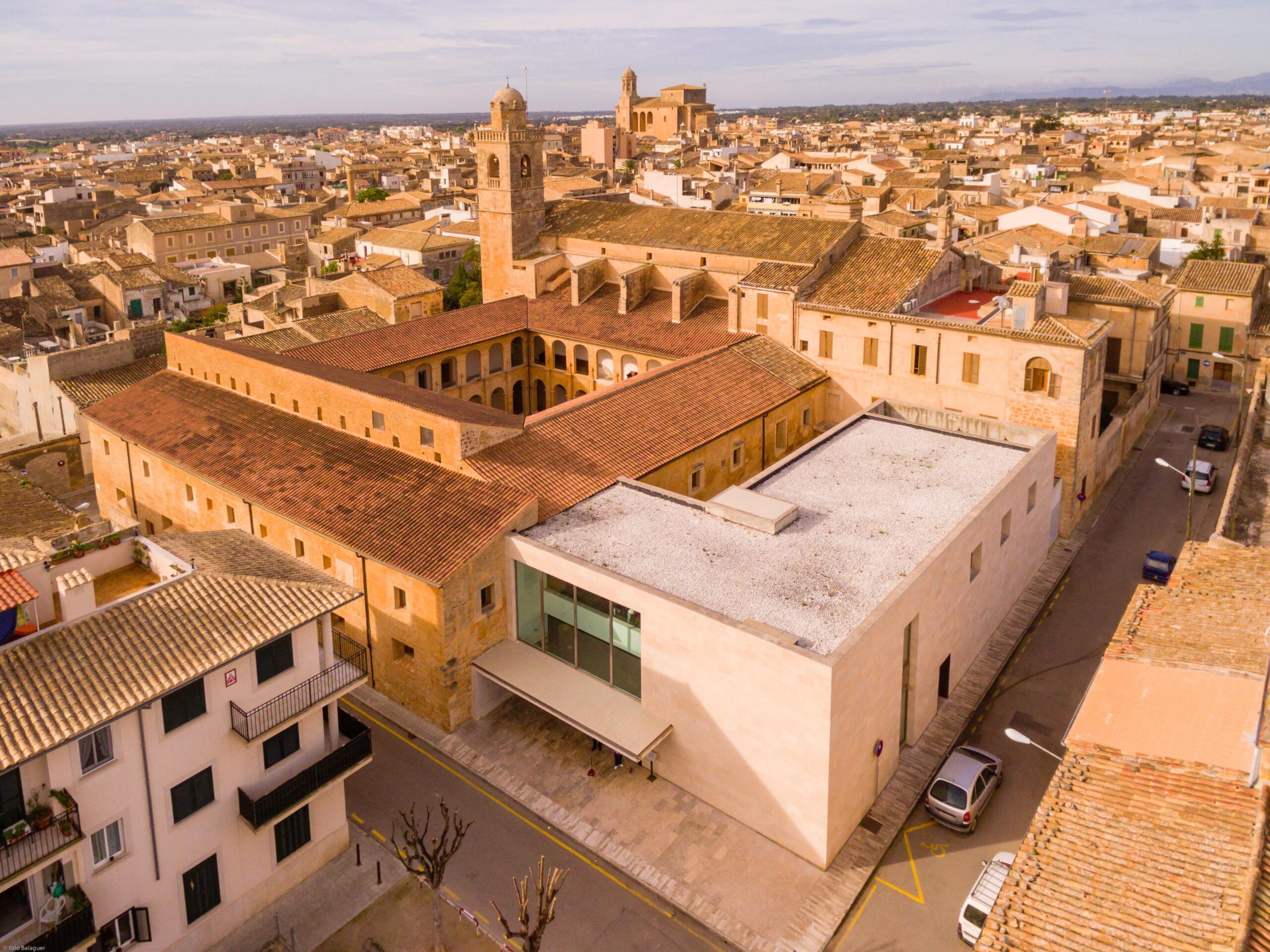
The old town of Llucmajor: architecture and squares with a life of their own
The historic center of Llucmajor retains a spacious and well-defined urban structure, with straight streets and stone buildings, the result of the growth the town experienced between the 18th and 19th centuries. Unlike other Mallorcan towns with more irregular layouts, here you can breathe a sense of order and spaciousness, ideal for strolling without rushing and stopping to take in the details.
The heart of the old town is the Plaça d’Espanya, a large tree-lined esplanade that serves as a central meeting place. This is where the market is held, concerts and fairs are organized, and it is common to see locals chatting on the terraces. The square is dominated by the neoclassical town hall building and flanked by cafés, bars, and local shops that maintain the neighborhood’s character.
A few meters away stands one of the town’s most recognizable landmarks: the parish church of Sant Miquel, an imposing late Gothic building with a sober façade and a surprisingly bright interior. Built on top of an older church, it was enlarged in several stages, giving it a unique appearance. Its bell tower and large rose window are visible from different points in the town.
In addition to Sant Miquel, the old town preserves stately houses from the 18th and 19th centuries, with carved stone doorways, large windows with ornamental grilles, and interior courtyards that are filled with flower pots in summer. Some of these houses have been renovated as cultural spaces or charming shops, maintaining their original structure.
Another highlight is the Plaça del Sabater, a more intimate square where shoemakers used to gather. For decades, Llucmajor was one of the island’s main shoe-making centers, and even today it is still possible to find workshops that are still active, maintaining the manufacturing tradition.
Walking through the old town of Llucmajor is not only a way to discover its architecture, but also to discover the rhythm of local life, the greetings between neighbors, the shop windows that blend tradition and modernity, and the quiet hospitality of a town that has never ceased to be a town.
Markets and local life in Llucmajor
One of the best times to discover the everyday character of Llucmajor is during its market days, when the streets of the town center fill with stalls, locals, and visitors. The busiest is the Wednesday market, one of the largest in southern Mallorca, which is held outdoors around Plaça d’Espanya and the adjacent streets. There is also a market on Fridays and Sundays, although with fewer stalls.
There you can find a wide variety of fresh produce: seasonal fruits and vegetables, seasoned olives, local cheeses, artisan sausages, and honey from small producers in the area. The aromas mingle with the buzz of conversation in Mallorcan, Spanish, and German, and it is easy to strike up a conversation with the vendors, many of whom are families who have been in the business for generations.
In addition to food products, the market includes stalls selling clothing, footwear, basketry, and ceramics, mostly in traditional styles. Flowers, kitchen utensils, and everyday items are also available, making it a true reflection of local commerce, where people shop more out of necessity than for tourism.
The Llucmajor market is not just an attraction for visitors: it is a meeting point for the inhabitants of the village and the nearby farms, who take the opportunity to socialize, have a coffee on the terraces, or run errands. It is common to see older people chatting under the trees, younger people having a drink in the bars in the center, and families strolling calmly among the stalls.
Beyond the market, the town maintains an active commercial fabric, with local shops, traditional bakeries, butchers, and grocery stores that are holding their own against the big supermarkets. In these shops, visitors can find local specialties and receive personalized recommendations, something that is increasingly difficult to find in crowded tourist destinations.
Visiting Llucmajor on market day is a direct way to get in touch with its real life and enjoy an atmosphere that, without pretensions, preserves the authenticity that so many travelers value.
When is the weekly market in Llucmajor?
The weekly market in Llucmajor is an event not to be missed. It takes place every Wednesday, Friday, and Sunday and offers a wide variety of products, from food to handicrafts.
Visitors can stroll among the stalls and discover authentic local products. The market is also a social meeting place where you can experience the warm hospitality of the people of Llucmajor.
The Friday market is particularly well known for its size and diversity. Traders from all over the region come here to offer their products, making the market a meeting place for both locals and tourists.
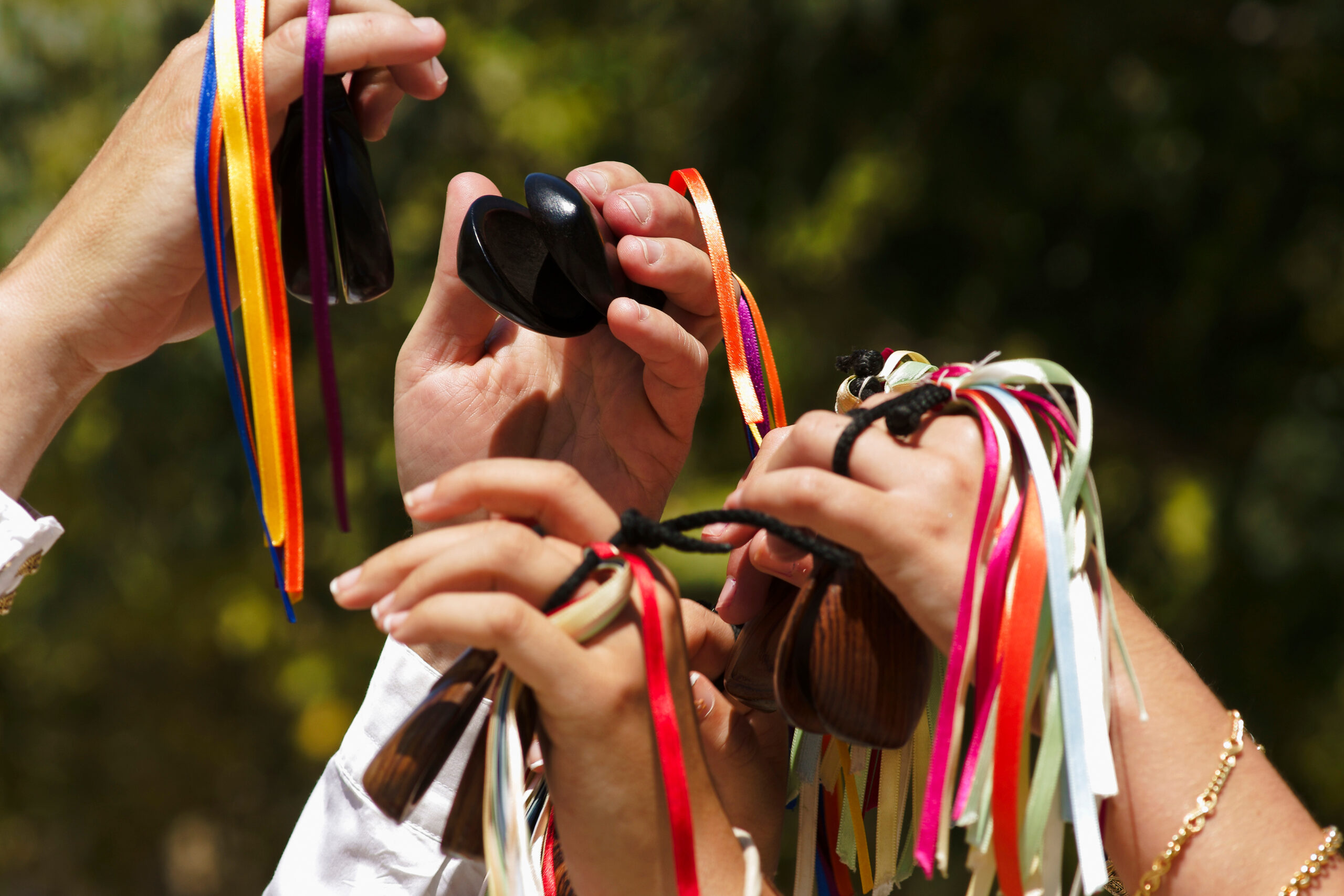
Local traditions and festivals
The cultural life of Llucmajor is deeply linked to its festive calendar, which preserves traditions with centuries of history and maintains active community participation. Far from becoming spectacles designed solely for tourists, the town’s festivals remain key moments for local identity, with a mix of religious celebrations, themed markets, popular music, and gastronomy.
The most important festival of the year is that of Sant Miquel, the town’s patron saint, which is celebrated on September 29. For several days, Llucmajor is filled with activities: parades, open-air concerts, theater, equestrian exhibitions, traditional dances, and fireworks. It is an ideal opportunity to see the xeremiers (musicians with Mallorcan bagpipes), groups of ball de bot and processions in which the religious and the festive coexist.
Along with Sant Miquel, the Fira de Tardor, an autumn fair held on the Sundays after the patron saint’s day, is also worth mentioning. This fair, which attracts thousands of people from all over the island, has a marked agricultural and commercial character. Visitors can find handicrafts, machinery, animals, plants, traditional sweets, and a wide variety of food stalls. It is considered one of the oldest and largest fairs in Mallorca, with more than 400 years of documented history.
During the spring, the Fira del Llonguet is also held, a gastronomic festival dedicated to this typical bread roll from the Palma and Llucmajor area, ideal for making sandwiches with local ingredients. At this fair, the municipality’s bakers show off their creativity with a variety of recipes, and visitors can taste the products in a relaxed atmosphere, accompanied by live music and activities for families.
In addition to these main festivities, Llucmajor maintains smaller but deeply rooted traditions, such as the summer neighborhood festivals, the Holy Week celebrations, and the patron saint festivals of the different neighborhoods in the municipality, such as Cala Pi, s’Arenal, and s’Estanyol, which combine masses, popular contests, outdoor meals, and sports tournaments.
Participating in any of these festivals is a direct way to understand how Mallorcan culture remains alive in its villages, not only as a folkloric element, but as a daily expression of a community that comes together, recognizes itself, and celebrates.
Gastronomy in Llucmajor
Eating in Llucmajor is an opportunity to discover authentic Mallorcan cuisine, just as it is served in homes and restaurants in the interior of the island. Far from tourist menus or modern fusions, traditional dishes predominate here, made with local products and at a leisurely pace, as is customary in agricultural villages.
The restaurants and cellers in the center offer menus based on traditional recipes, such as frit mallorquí, sobrasada with honey, tumbet, snails with aioli, and arròs brut, a rice dish with meat, vegetables, and spices. The quality of the ingredients is the basis of these dishes, many of which are prepared with seasonal vegetables, extra virgin olive oil, and meat from nearby family farms.
Pastries also play an important role in the local cuisine. In the bakeries of Llucmajor, you can find freshly baked ensaïmades, both plain and filled with angel hair or cream, as well as typical sweets for special occasions, such as robiols and panades at Easter. Cocas saladas (savory flatbreads) with trampó (a type of sausage) or vegetables are common for breakfast or as a snack to take to the countryside.
In the surrounding area, there are several family-run wineries that produce wines from native varieties such as callet and prensal blanc, and offer guided tours and tastings in a rural setting. It is also possible to buy artisan products directly in village shops or at the market, from homemade jams and sausages to olive oil and fleur de sel.
For those who want a more complete gastronomic experience, a special option is to stay at estates that combine relaxation with the culture of local products, such as Finca Treurer, located on the outskirts of the village. In this olive-growing setting, you can learn about the production of extra virgin olive oil, attend dinners featuring locally sourced products, and sample Mallorcan cuisine from a peaceful perspective, linked to the land and the rhythm of the countryside.
In Llucmajor, eating well is not a luxury, but a natural part of everyday life. It is a reflection of its rural identity and appreciation for authentic flavors.
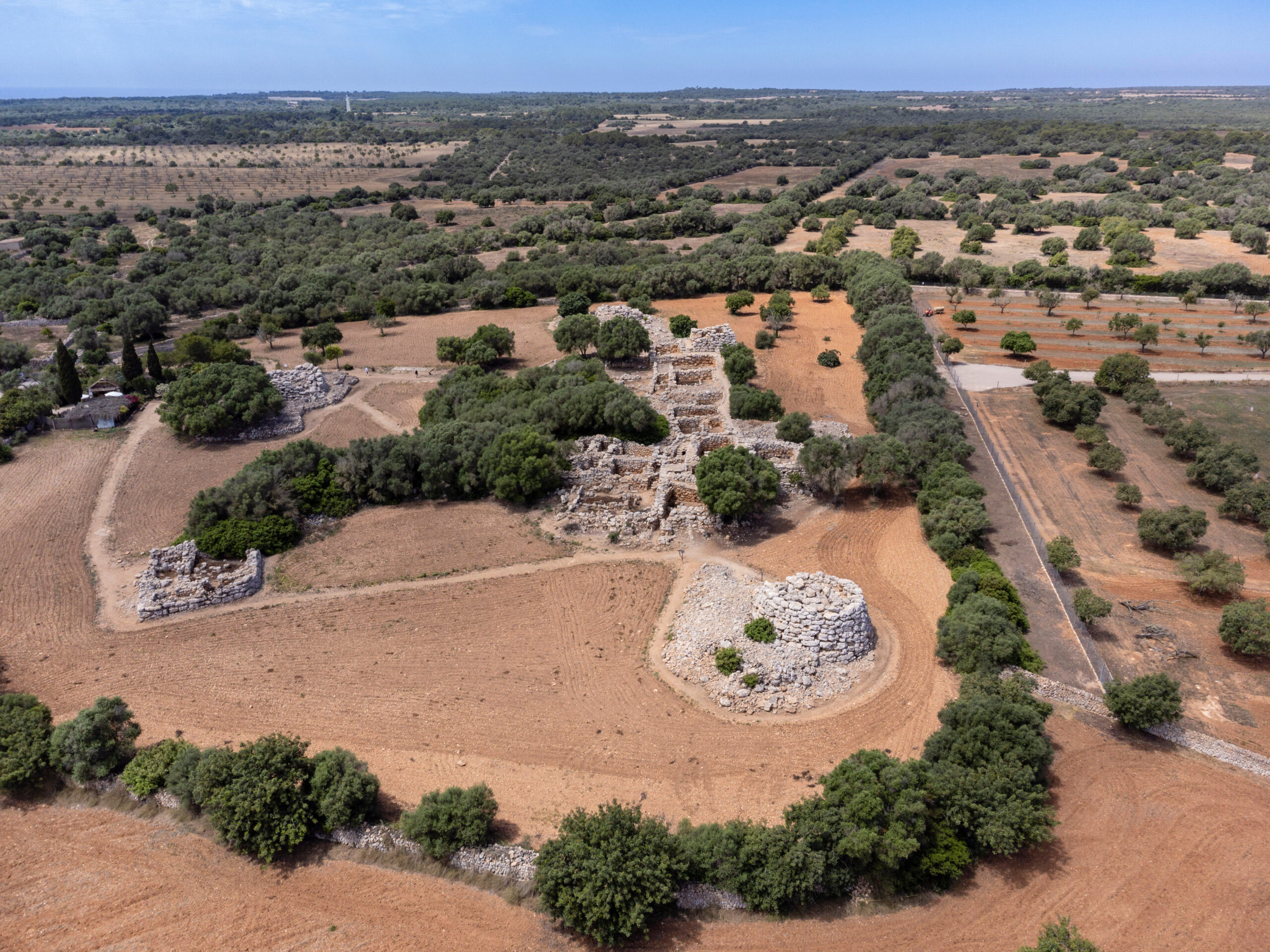
Surroundings and excursions from the village
Llucmajor is an excellent starting point for exploring the south of Mallorca, both because of its central location and the variety of landscapes and places of interest that surround it. A short distance from the town center, visitors can discover everything from prehistoric archaeological sites to historic monasteries, passing through rural roads, vineyards, and uncrowded stretches of coastline.
One of the most unique places is the Talayotic settlement of Capocorb Vell, located about 10 kilometers to the south. This is one of the most important archaeological sites on the island, where several cyclopean constructions have been preserved, allowing visitors to imagine how the prehistoric communities that inhabited this part of Mallorca more than 3,000 years ago lived. A visit to the site, in a clear and quiet setting, is both historically and scenically rewarding.
To the northeast, towards Algaida, is the Randa mountain, crowned by the Santuari de Cura, a place of contemplation and panoramic views that has been a destination for pilgrims since the Middle Ages. The climb can be done by car or, for the more active, on foot or by bike, following a route that passes through pine and holm oak forests. From the top, you can see much of the island, and on clear days, you can see both the Bay of Palma and the deep Migjorn.
For those seeking contact with nature, the rural surroundings of Llucmajor offer farm tracks, cycling routes and trails among almond trees, fig trees and vineyards. Many estates open their doors to visitors, either as accommodation or as agrotourism sites where you can learn about the production of oil, wine or seasonal fruit.
The municipality’s coastline, often overshadowed by other more touristy areas, hides some really cool spots. Places like Cala Pi, with its defensive tower and beach nestled between low cliffs, or S’Estanyol de Migjorn, next to the salt marshes, are ideal for quiet getaways. Cap Blanc, with its lonely lighthouse and views of the open sea, is perfect for those looking for peace and quiet and beautiful scenery.
From the town of Llucmajor itself, it is easy to organize these half-day excursions, combining them with cultural visits, meals in local restaurants, or simply an afternoon of rest among olive trees. In this sense, the municipality offers visitors a range of nearby, varied, and uncrowded experiences, suitable for those who value the leisurely discovery of the island.
Accommodation with character
The municipality of Llucmajor offers a variety of accommodation options that are far removed from mass tourism and focus on peace and quiet, beautiful scenery, and personalized service. Most of the options are located in the town center or scattered among farmland, with open views, natural silence, and traditional stone buildings that have been restored with respect for their original character.
Many of these accommodations operate as agritourism or rural estates, integrating agricultural activity with lodging. These are spaces where visitors can relax in spacious rooms, sample local products, read by a pool overlooking the countryside, or simply observe the rhythm of rural life without schedules or interruptions.
Among these options, Finca Treurer stands out, an accommodation with its own identity, located in the heart of an olive-growing area just a few minutes from the center of Llucmajor. This estate combines the comfort of a high-end hotel with a cultural experience linked to extra virgin olive oil. Guests not only relax in a meticulously cared-for environment, but can also learn about the process of growing, harvesting, and producing the oil, take part in guided tastings, and enjoy dinners featuring seasonal products.
Staying at Finca Treurer is not just a matter of comfort, but a way to connect with the Mallorcan landscape and culture from the ground up. The surroundings invite you to stroll among olive trees, enjoy the silence and experience a form of tourism that prioritizes quality over excess.
In addition to estates such as Treurer, Llucmajor has boutique hotels in the center of town, vacation rentals with typical Mallorcan architecture, and small rural inns. All of them share a common desire: to offer authentic, unpretentious hospitality with details that make all the difference.
Thanks to their strategic location, these accommodations allow you to combine relaxation with exploring the entire Migjorn region, from the sanctuary of Cura to the beaches of Es Trenc, and return at the end of the day to a place where time seems to stand still, without sacrificing any comforts.
Here is point 10: Practical tips for visitors, designed to guide travelers who want to explore Llucmajor comfortably and wisely:
Practical tips for visitors
Getting to Llucmajor is easy, thanks to its proximity to Palma airport, just 15 minutes away by road, and its direct connection to the Ma-19 motorway. This easy access makes the municipality an ideal base for exploring both the south and center of Mallorca, avoiding long journeys and the busiest areas.
The best time to visit Llucmajor depends on the type of experience you are looking for. Spring and fall offer mild temperatures, green fields, and an active cultural calendar, especially around the fairs. Summer, although warmer, allows you to combine visits to the town with trips to the nearby coast. Winter, on the other hand, is quiet and ideal for those who want to discover inland Mallorca at a leisurely pace.
Getting around the area is easy with your own car or a rental, as many of the estates, wineries, and points of interest are scattered throughout the municipality. For those who prefer not to drive, there are regular bus connections from Palma to the center of Llucmajor, although these are limited outside the high season.
In terms of services, visitors will find everything they need in the center of town: pharmacies, banks, supermarkets, bakeries, restaurants, tobacconists, and shops selling local products. The tourist office, located in the main square, offers maps and up-to-date information on events and cultural activities.
Market days—Wednesday, Friday, and Sunday—are especially recommended for planning your visit.
Not only because of the variety of products on offer, but also because of the lively atmosphere that fills the squares and streets of the old town.
Llucmajor is a destination that can be discovered in a day, but it is worth staying a few days to explore its surroundings and let yourself be carried away by its leisurely, hospitable and authentic rhythm. It is a place that invites you to look beyond the obvious and enjoy the Mallorca that still retains its essence.


